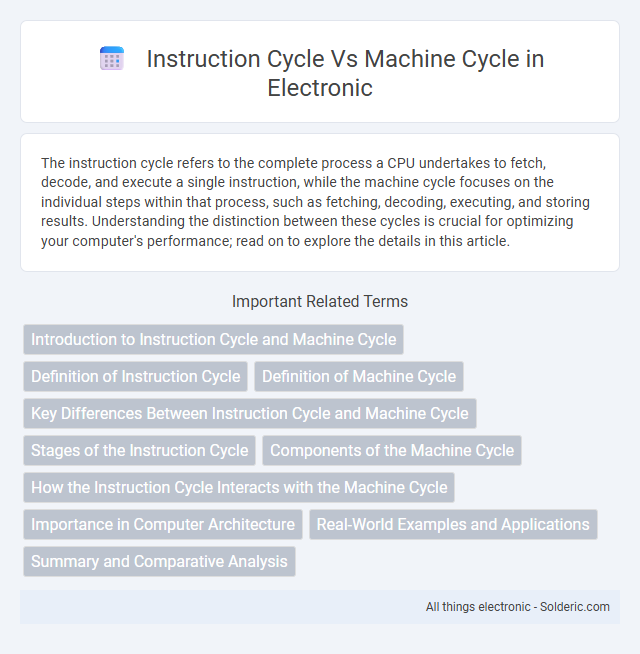The instruction cycle refers to the complete process a CPU undertakes to fetch, decode, and execute a single instruction, while the machine cycle focuses on the individual steps within that process, such as fetching, decoding, executing, and storing results. Understanding the distinction between these cycles is crucial for optimizing your computer's performance; read on to explore the details in this article.
Comparison Table
| Aspect | Instruction Cycle | Machine Cycle |
|---|---|---|
| Definition | Complete process to fetch, decode, and execute one instruction. | Basic operation cycle within the instruction cycle, e.g., fetch or execute. |
| Components | Fetch, Decode, Execute, Store (might vary by CPU). | Typically includes Fetch Cycle, Decode Cycle, Execute Cycle. |
| Duration | Multiple machine cycles combined. | Single step or phase in processing an instruction. |
| Purpose | Execute a full instruction in the program. | Perform a specific operation within an instruction cycle. |
| Example | Fetching instruction from memory, decoding, then executing it. | Fetching opcode from memory during fetch phase. |
Introduction to Instruction Cycle and Machine Cycle
The instruction cycle refers to the process a CPU follows to fetch, decode, and execute a single instruction, encompassing stages such as instruction fetch, instruction decode, operand fetch, execution, and store result. The machine cycle is a subset of the instruction cycle, focusing primarily on the basic operations of fetching and storing data, typically including the machine's timing cycles for memory read/write and I/O operations. Understanding the distinction highlights that the instruction cycle represents the complete execution process of instructions, while the machine cycle defines the fundamental hardware steps during instruction processing.
Definition of Instruction Cycle
The instruction cycle is the process a computer's CPU follows to fetch, decode, and execute a single instruction, encompassing multiple machine cycles. Each machine cycle performs a distinct operation, such as fetching an instruction or reading/writing data. Understanding the instruction cycle helps optimize Your computer's performance by clarifying how instructions are processed at a fundamental level.
Definition of Machine Cycle
The machine cycle refers to the fundamental process a CPU follows to execute a single machine-level instruction, encompassing stages such as fetching, decoding, executing, and storing results. It represents the lowest-level operational sequence within the CPU, managing bit-level communication between the processor and memory. Understanding the machine cycle helps optimize Your system's overall efficiency by highlighting the time taken for each micro-operation during instruction processing.
Key Differences Between Instruction Cycle and Machine Cycle
The instruction cycle includes fetching, decoding, and executing an instruction, encompassing multiple machine cycles, while the machine cycle specifically refers to the basic operations required to complete a single step such as fetch, decode, or execute. Your CPU completes multiple machine cycles to finish one instruction cycle, indicating the machine cycle is a subset of the instruction cycle. Key differences lie in their scope and function: the instruction cycle manages the entire process of executing instructions, whereas the machine cycle processes discrete operations within that sequence.
Stages of the Instruction Cycle
The instruction cycle consists of four main stages: fetch, decode, execute, and store, during which the CPU retrieves an instruction from memory, interprets it, carries out the operation, and writes back results if necessary. The machine cycle, often a subset of the instruction cycle, includes specific steps such as memory read/write and processing unit operations required to complete each instruction. Understanding the stages of the instruction cycle is crucial for optimizing CPU performance and effective instruction execution management.
Components of the Machine Cycle
The machine cycle consists of four primary components: fetch, decode, execute, and store. During the fetch phase, the instruction is retrieved from memory, followed by decoding to determine the required action. Execution carries out the instruction, and the store phase saves the results back to memory or registers, ensuring your computer processes instructions efficiently.
How the Instruction Cycle Interacts with the Machine Cycle
The instruction cycle consists of multiple machine cycles that work together to fetch, decode, and execute a single instruction in a CPU. Each machine cycle handles a specific task, such as memory read, memory write, or I/O operations, enabling the overall instruction cycle to progress sequentially. Understanding how your instruction cycle interacts with the machine cycle enhances your ability to optimize processor performance and instruction throughput.
Importance in Computer Architecture
The instruction cycle and machine cycle are fundamental to understanding computer architecture because they define how processors execute commands and process data efficiently. The instruction cycle encompasses fetching, decoding, and executing instructions, while the machine cycle breaks down these steps into smaller hardware-level operations like memory access and ALU computations. Optimizing these cycles enhances CPU performance, improves instruction throughput, and reduces latency, critical for designing high-speed and efficient computer systems.
Real-World Examples and Applications
The instruction cycle, which involves fetching, decoding, and executing instructions, is fundamental in operating your computer's software, such as running applications or processing user commands. The machine cycle, consisting of fetch, decode, execute, and store phases, directly controls hardware tasks like reading from memory or performing arithmetic operations in embedded systems and microcontrollers. Understanding these cycles helps optimize performance in real-world devices like smartphones, gaming consoles, and industrial automation systems.
Summary and Comparative Analysis
The instruction cycle consists of multiple machine cycles, including fetch, decode, and execute phases, whereas the machine cycle refers specifically to the single operations required to complete these phases. Your understanding improves by recognizing that the instruction cycle represents the full process of executing an instruction, while the machine cycle breaks down this process into smaller, hardware-level steps, enabling precise performance analysis and optimization. This distinction highlights the granularity difference, with instruction cycle encompassing several machine cycles to complete tasks within a CPU.
instruction cycle vs machine cycle Infographic

 solderic.com
solderic.com